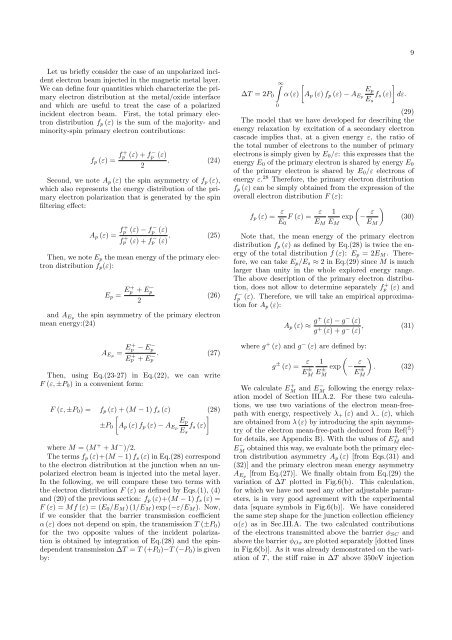Etudes par microscopie en champ proche des phénomènes de ...
Etudes par microscopie en champ proche des phénomènes de ...
Etudes par microscopie en champ proche des phénomènes de ...
You also want an ePaper? Increase the reach of your titles
YUMPU automatically turns print PDFs into web optimized ePapers that Google loves.
9Let us briefly consi<strong>de</strong>r the case of an unpolarized incid<strong>en</strong>telectron beam injected in the magnetic metal layer.We can <strong>de</strong>fine four quantities which characterize the primaryelectron distribution at the metal/oxi<strong>de</strong> interfaceand which are useful to treat the case of a polarizedincid<strong>en</strong>t electron beam. First, the total primary electrondistribution f p (ε) is the sum of the majority- andminority-spin primary electron contributions:f p (ε) = f p + (ε)+fp − (ε). (24)2Second, we note A p (ε) the spin asymmetry of f p (ε),which also repres<strong>en</strong>ts the <strong>en</strong>ergy distribution of the primaryelectron polarization that is g<strong>en</strong>erated by the spinfiltering effect:A p (ε) = f + p (ε) − f − p (ε)f + p (ε)+f − p (ε) . (25)Th<strong>en</strong>, we note E p the mean <strong>en</strong>ergy of the primary electrondistribution f p (ε):E p = E+ p + Ep− (26)2and A Ep the spin asymmetry of the primary electronmean <strong>en</strong>ergy:(24)A Ep = E+ p − Ep−E p+ + Ep− . (27)Th<strong>en</strong>, using Eq.(23-27) in Eq.(22), we can writeF (ε, ±P 0 ) in a conv<strong>en</strong>i<strong>en</strong>t form:F (ε, ±P 0 )= f p (ε)+(M − 1) f s (ε) (28)[]E p±P 0 A p (ε) f p (ε) − A Ep f s (ε)E swhere M =(M + + M − )/2.The terms f p (ε)+(M − 1) f s (ε) in Eq.(28) correspondto the electron distribution at the junction wh<strong>en</strong> an unpolarize<strong>de</strong>lectron beam is injected into the metal layer.In the following, we will com<strong>par</strong>e these two terms withthe electron distribution F (ε) as <strong>de</strong>fined by Eqs.(1), (4)and (20) of the previous section: f p (ε)+(M − 1) f s (ε) =F (ε) =Mf (ε) =(E 0 /E M )(1/E M )exp(−ε/E M ). Now,if we consi<strong>de</strong>r that the barrier transmission coeffici<strong>en</strong>tα (ε) does not <strong>de</strong>p<strong>en</strong>d on spin, the transmission T (±P 0 )for the two opposite values of the incid<strong>en</strong>t polarizationis obtained by integration of Eq.(28) and the spin<strong>de</strong>p<strong>en</strong>d<strong>en</strong>ttransmission ΔT = T (+P 0 )−T (−P 0 )isgiv<strong>en</strong>by:∫∞[]E pΔT =2P 0 α (ε) A p (ε) f p (ε) − A Ep f s (ε) dε.E s0(29)The mo<strong>de</strong>l that we have <strong>de</strong>veloped for <strong><strong>de</strong>s</strong>cribing the<strong>en</strong>ergy relaxation by excitation of a secondary electroncasca<strong>de</strong> implies that, at a giv<strong>en</strong> <strong>en</strong>ergy ε, theratioofthe total number of electrons to the number of primaryelectrons is simply giv<strong>en</strong> by E 0 /ε: this expresses that the<strong>en</strong>ergy E 0 of the primary electron is shared by <strong>en</strong>ergy E 0of the primary electron is shared by E 0 /ε electrons of<strong>en</strong>ergy ε. 28 Therefore, the primary electron distributionf p (ε) can be simply obtained from the expression of theoverall electron distribution F (ε):f p (ε) = ε F (ε) = ε (1exp − ε )(30)E 0 E M E M E MNote that, the mean <strong>en</strong>ergy of the primary electrondistribution f p (ε) as <strong>de</strong>fined by Eq.(28) is twice the <strong>en</strong>ergyof the total distribution f (ε): E p =2E M . Therefore,we can take E p /E s ≈ 2 in Eq.(29) since M is muchlarger than unity in the whole explored <strong>en</strong>ergy range.The above <strong><strong>de</strong>s</strong>cription of the primary electron distribution,does not allow to <strong>de</strong>termine se<strong>par</strong>ately f p+ (ε) andfp− (ε). Therefore, we will take an empirical approximationfor A p (ε):A p (ε) ≈ g+ (ε) − g − (ε)g + (ε)+g − (ε) , (31)where g + (ε) andg − (ε) are <strong>de</strong>fined by:g ± (ε) =ε (1E ± ME ± exp − ε )ME ± . (32)MWe calculate E + M and E− Mfollowing the <strong>en</strong>ergy relaxationmo<strong>de</strong>l of Section III.A.2. For these two calculations,we use two variations of the electron mean-freepathwith <strong>en</strong>ergy, respectively λ + (ε) andλ − (ε), whichare obtained from λ (ε) by introducing the spin asymmetryof the electron mean-free-path <strong>de</strong>duced from Ref( 5 )for <strong>de</strong>tails, see App<strong>en</strong>dix B). With the values of E + M andE − Mobtained this way, we evaluate both the primary electrondistribution asymmetry A p (ε) [from Eqs.(31) and(32)] and the primary electron mean <strong>en</strong>ergy asymmetryA Ep [from Eq.(27)]. We finally obtain from Eq.(29) thevariation of ΔT plotted in Fig.6(b). This calculation,for which we have not used any other adjustable <strong>par</strong>ameters,is in very good agreem<strong>en</strong>t with the experim<strong>en</strong>taldata [square symbols in Fig.6(b)]. We have consi<strong>de</strong>redthe same step shape for the junction collection effici<strong>en</strong>cyα(ε) as in Sec.III.A. The two calculated contributionsof the electrons transmitted above the barrier φ SC andabove the barrier φ Ox are plotted se<strong>par</strong>ately [dotted linesin Fig.6(b)]. As it was already <strong>de</strong>monstrated on the variationof T , the stiff raise in ΔT above 350eV injection










![[Diffusion-Limited Aggregation - A Model for Pattern Formation].](https://img.yumpu.com/52395246/1/190x245/diffusion-limited-aggregation-a-model-for-pattern-formation.jpg?quality=85)





